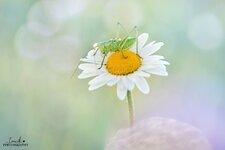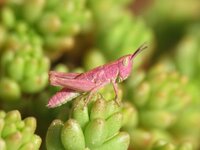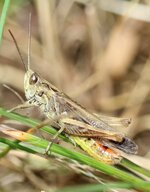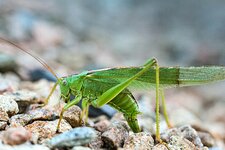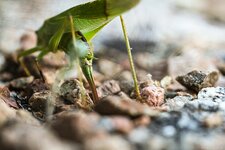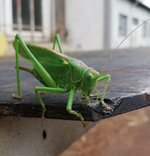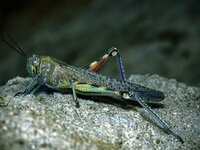Closed Theme Grasshopper / Leafhopper theme
- Thread starter Helix_2648
- Start date
You are using an out of date browser. It may not display this or other websites correctly.
You should upgrade or use an alternative browser.
You should upgrade or use an alternative browser.
Welcome to our Community
Wanting to join the rest of our members? Feel free to sign up today.
Join now!
The Photo Theme is closed for entries and commenting.
- Status
- Not open for further replies.
I like this grasshopper / leafhopper theme, although this is also my first post, so I'm not sure if I'm doing this right.
Here is a pink grasshopper on Sedum that I found near Silverdale, Lancashire, taken 28 May, 2020, 16:14 BST, using Canon PowerShot SX540 HS and a custom macro lens built from an old Zenit lens.
View attachment 15240
Here is info that I could find on it:
(I think the species is Pseudochorthippus parallelus and/or Omocestus viridulus)
From what I could find, the pink pigmentation seems to be due to erythrism. Erythrism is the name for genetic mutations which cause unusual reddishness in the pigments of an organism’s hair, skin, feathers, or eggs. The word can also refer to how this change in pigmentation can come around due to red pigments in the diet being visible on the organism itself but is most commonly known for its genetic origins. The condition has been observed in individuals throughout the animal tree, from leopards, to badgers, and many more. However, the condition is most prominent in orthoptera species (including grasshoppers, locusts, and crickets), as it often causes them to be a bright pink, rather than just having paler and more reddish tinges like with other erythristic organisms. Erythristic grasshoppers and katydids also seem to be among the most commonly seen erythristic species, despite the mutation reducing the production of normal green colourations and producing pink being seen as recessive. One reason for this could be that the pink-causing genes are actually dominant, as suggested by studies from the Audubon Butterfly Garden and Insectarium. In a study directed by entomologist Jayme Necaise in 2008, 8 male and female pink katydids of the species Amblycorypha oblongifolia were bred, and later on, other colour variants of the normally green katydid species were added in orange and yellow. Having bred and raised these in the same enclosure, where the various variants could interbreed, pink was quickly noticed to be an exception to the others. During development, orange and yellow katydids are born green, with green eyes, and develop their different colour over various moults as they grow, while retaining their green eyes, and it was even recorded that one yellow katydid eventually moulted to become orange instead. Pink katydids on the other hand, hatch out pink with pink eyes, and stay this way throughout all the moults of their lives. After this initial note from the captive breeding of katydids, Necaise’s team set out to find which colour was dominant out of green, yellow, orange, and pink, using the basic Mendelian inheritance system and the hypothesis that green was dominant since it is by far the most common naturally occurring colour. As a highly simplified example of how this works, assume that there are two colour alleles, pink and green, labelled p and G. It is assumed that both are variants of the same allele on equivalent chromosomes (diploid organisms have a pair of each chromosome, one from each parent), such that if both chromosomes carried the G allele, the katydid is green, and if both carry the p allele, the katydid is pink. Assuming that G is dominant, in cases where the katydid is heterozygous (has one of each allele), noted as Gp or pG, the katydid ends up having G characteristics, and so is green. From here, you can use the proportions of colouration in the offspring to work out the parents’ alleles, for example, if there is a 3:1 ratio of green: pink, then this statistically suggests that both parents were heterozygous, since the only possible combinations (assumed to happen with equal chance) are GG, Gp, pG, and pp, so forming a 1 in 3 chance of pp, the only possible way to form pink in this situation. From similar ideas, the research team bred two pink female katydids with one pink male to get 35 eggs. Since the pink allele was assumed recessive, all parents would be homozygous pp, so the only combination is pp, meaning 100% pink offspring, however, of the 35, 4 ended up green. Due to the small sample size, it is assumed that this roughly relates to a 1:3 ratio of green: pink and means that both parents must have also been carrying the green allele, despite being pink. After this, more experiments were done, using the various colours, including green, and switching which parent was of a particular colour to try and test whether there were any sex-related pigment genes, and the results suggest that the common green gene is actually more recessive than the other three, much rarer, colours. To further support this argument, wild green katydids were caught and bred in captivity, and repeatedly were unable to produce any colour other than green, suggesting that they were all homozygous recessive. This study wasn’t at a large enough scale to be as certain as I would like, but if the results are correct, there must be a reason for there being more green katydids than pink. This is likely due to environmental pressures, as green allows them to better blend in with plant foliage, and so green katydids are more likely to survive to reproduce to produce green offspring, while pink, yellow, or orange ones are less likely to reach sexual maturity, and may be easily spotted and eaten by a predator. My finds weren’t katydids, but having found two pink grasshoppers in such a short period of time, and having heard various other reports of them, it seems plausible that the condition may also be dominant in this very closely related species (although neither of my observations show the pink eyes too).
Here is a pink grasshopper on Sedum that I found near Silverdale, Lancashire, taken 28 May, 2020, 16:14 BST, using Canon PowerShot SX540 HS and a custom macro lens built from an old Zenit lens.
View attachment 15240
Here is info that I could find on it:
(I think the species is Pseudochorthippus parallelus and/or Omocestus viridulus)
From what I could find, the pink pigmentation seems to be due to erythrism. Erythrism is the name for genetic mutations which cause unusual reddishness in the pigments of an organism’s hair, skin, feathers, or eggs. The word can also refer to how this change in pigmentation can come around due to red pigments in the diet being visible on the organism itself but is most commonly known for its genetic origins. The condition has been observed in individuals throughout the animal tree, from leopards, to badgers, and many more. However, the condition is most prominent in orthoptera species (including grasshoppers, locusts, and crickets), as it often causes them to be a bright pink, rather than just having paler and more reddish tinges like with other erythristic organisms. Erythristic grasshoppers and katydids also seem to be among the most commonly seen erythristic species, despite the mutation reducing the production of normal green colourations and producing pink being seen as recessive. One reason for this could be that the pink-causing genes are actually dominant, as suggested by studies from the Audubon Butterfly Garden and Insectarium. In a study directed by entomologist Jayme Necaise in 2008, 8 male and female pink katydids of the species Amblycorypha oblongifolia were bred, and later on, other colour variants of the normally green katydid species were added in orange and yellow. Having bred and raised these in the same enclosure, where the various variants could interbreed, pink was quickly noticed to be an exception to the others. During development, orange and yellow katydids are born green, with green eyes, and develop their different colour over various moults as they grow, while retaining their green eyes, and it was even recorded that one yellow katydid eventually moulted to become orange instead. Pink katydids on the other hand, hatch out pink with pink eyes, and stay this way throughout all the moults of their lives. After this initial note from the captive breeding of katydids, Necaise’s team set out to find which colour was dominant out of green, yellow, orange, and pink, using the basic Mendelian inheritance system and the hypothesis that green was dominant since it is by far the most common naturally occurring colour. As a highly simplified example of how this works, assume that there are two colour alleles, pink and green, labelled p and G. It is assumed that both are variants of the same allele on equivalent chromosomes (diploid organisms have a pair of each chromosome, one from each parent), such that if both chromosomes carried the G allele, the katydid is green, and if both carry the p allele, the katydid is pink. Assuming that G is dominant, in cases where the katydid is heterozygous (has one of each allele), noted as Gp or pG, the katydid ends up having G characteristics, and so is green. From here, you can use the proportions of colouration in the offspring to work out the parents’ alleles, for example, if there is a 3:1 ratio of green: pink, then this statistically suggests that both parents were heterozygous, since the only possible combinations (assumed to happen with equal chance) are GG, Gp, pG, and pp, so forming a 1 in 3 chance of pp, the only possible way to form pink in this situation. From similar ideas, the research team bred two pink female katydids with one pink male to get 35 eggs. Since the pink allele was assumed recessive, all parents would be homozygous pp, so the only combination is pp, meaning 100% pink offspring, however, of the 35, 4 ended up green. Due to the small sample size, it is assumed that this roughly relates to a 1:3 ratio of green: pink and means that both parents must have also been carrying the green allele, despite being pink. After this, more experiments were done, using the various colours, including green, and switching which parent was of a particular colour to try and test whether there were any sex-related pigment genes, and the results suggest that the common green gene is actually more recessive than the other three, much rarer, colours. To further support this argument, wild green katydids were caught and bred in captivity, and repeatedly were unable to produce any colour other than green, suggesting that they were all homozygous recessive. This study wasn’t at a large enough scale to be as certain as I would like, but if the results are correct, there must be a reason for there being more green katydids than pink. This is likely due to environmental pressures, as green allows them to better blend in with plant foliage, and so green katydids are more likely to survive to reproduce to produce green offspring, while pink, yellow, or orange ones are less likely to reach sexual maturity, and may be easily spotted and eaten by a predator. My finds weren’t katydids, but having found two pink grasshoppers in such a short period of time, and having heard various other reports of them, it seems plausible that the condition may also be dominant in this very closely related species (although neither of my observations show the pink eyes too).
Attachments
I have already crossed a pink grasshopper ... I think, also, it is a chromosomal aberration, because it is too visible to predators and should not survive for long in its environmentI like this grasshopper / leafhopper theme, although this is also my first post, so I'm not sure if I'm doing this right.
Here is a pink grasshopper on Sedum that I found near Silverdale, Lancashire, taken 28 May, 2020, 16:14 BST, using Canon PowerShot SX540 HS and a custom macro lens built from an old Zenit lens.
View attachment 15246
Here is info that I could find on it:
(I think the species is Pseudochorthippus parallelus and/or Omocestus viridulus)
From what I could find, the pink pigmentation seems to be due to erythrism. Erythrism is the name for genetic mutations which cause unusual reddishness in the pigments of an organism’s hair, skin, feathers, or eggs. The word can also refer to how this change in pigmentation can come around due to red pigments in the diet being visible on the organism itself but is most commonly known for its genetic origins. The condition has been observed in individuals throughout the animal tree, from leopards, to badgers, and many more. However, the condition is most prominent in orthoptera species (including grasshoppers, locusts, and crickets), as it often causes them to be a bright pink, rather than just having paler and more reddish tinges like with other erythristic organisms. Erythristic grasshoppers and katydids also seem to be among the most commonly seen erythristic species, despite the mutation reducing the production of normal green colourations and producing pink being seen as recessive. One reason for this could be that the pink-causing genes are actually dominant, as suggested by studies from the Audubon Butterfly Garden and Insectarium. In a study directed by entomologist Jayme Necaise in 2008, 8 male and female pink katydids of the species Amblycorypha oblongifolia were bred, and later on, other colour variants of the normally green katydid species were added in orange and yellow. Having bred and raised these in the same enclosure, where the various variants could interbreed, pink was quickly noticed to be an exception to the others. During development, orange and yellow katydids are born green, with green eyes, and develop their different colour over various moults as they grow, while retaining their green eyes, and it was even recorded that one yellow katydid eventually moulted to become orange instead. Pink katydids on the other hand, hatch out pink with pink eyes, and stay this way throughout all the moults of their lives. After this initial note from the captive breeding of katydids, Necaise’s team set out to find which colour was dominant out of green, yellow, orange, and pink, using the basic Mendelian inheritance system and the hypothesis that green was dominant since it is by far the most common naturally occurring colour. As a highly simplified example of how this works, assume that there are two colour alleles, pink and green, labelled p and G. It is assumed that both are variants of the same allele on equivalent chromosomes (diploid organisms have a pair of each chromosome, one from each parent), such that if both chromosomes carried the G allele, the katydid is green, and if both carry the p allele, the katydid is pink. Assuming that G is dominant, in cases where the katydid is heterozygous (has one of each allele), noted as Gp or pG, the katydid ends up having G characteristics, and so is green. From here, you can use the proportions of colouration in the offspring to work out the parents’ alleles, for example, if there is a 3:1 ratio of green: pink, then this statistically suggests that both parents were heterozygous, since the only possible combinations (assumed to happen with equal chance) are GG, Gp, pG, and pp, so forming a 1 in 3 chance of pp, the only possible way to form pink in this situation. From similar ideas, the research team bred two pink female katydids with one pink male to get 35 eggs. Since the pink allele was assumed recessive, all parents would be homozygous pp, so the only combination is pp, meaning 100% pink offspring, however, of the 35, 4 ended up green. Due to the small sample size, it is assumed that this roughly relates to a 1:3 ratio of green: pink and means that both parents must have also been carrying the green allele, despite being pink. After this, more experiments were done, using the various colours, including green, and switching which parent was of a particular colour to try and test whether there were any sex-related pigment genes, and the results suggest that the common green gene is actually more recessive than the other three, much rarer, colours. To further support this argument, wild green katydids were caught and bred in captivity, and repeatedly were unable to produce any colour other than green, suggesting that they were all homozygous recessive. This study wasn’t at a large enough scale to be as certain as I would like, but if the results are correct, there must be a reason for there being more green katydids than pink. This is likely due to environmental pressures, as green allows them to better blend in with plant foliage, and so green katydids are more likely to survive to reproduce to produce green offspring, while pink, yellow, or orange ones are less likely to reach sexual maturity, and may be easily spotted and eaten by a predator. My finds weren’t katydids, but having found two pink grasshoppers in such a short period of time, and having heard various other reports of them, it seems plausible that the condition may also be dominant in this very closely related species (although neither of my observations show the pink eyes too).
Attachments
Hi..exceptionally, I offer you 2 photos of the large green grasshopper Tettigonia (= Locusta) viridissima) laying eggs. On the second, we can clearly see the ovipositor planted in the ground, an organ through which the eggs are laid one by one in different places.
Attachments
- Status
- Not open for further replies.

